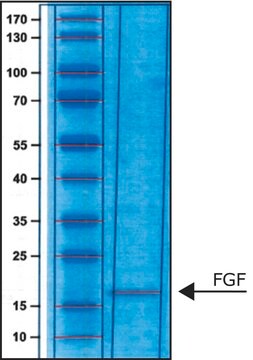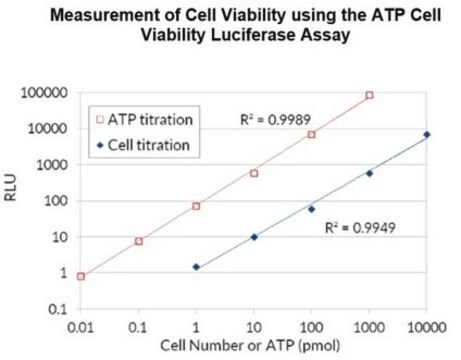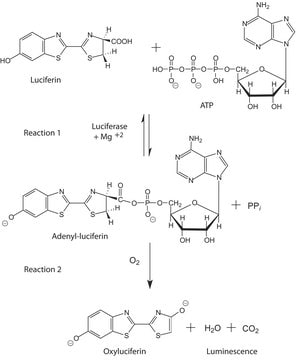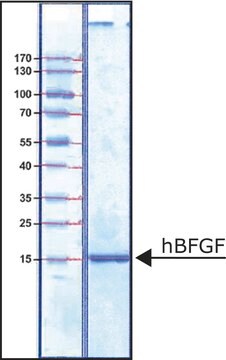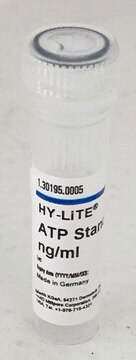FLAA
Adenosine 5′-triphosphate (ATP) Bioluminescent Assay Kit
for ATP quantitation
Sinonimo/i:
ATP Bioluminescence Assay, ATP Determination Kit, Luminescent ATP Detection kit
Autenticatiper visualizzare i prezzi riservati alla tua organizzazione & contrattuali
About This Item
Prodotti consigliati
Temperatura di conservazione
−20°C
Descrizione generale
The Adenosine 5′-triphosphate (ATP) Bioluminescent Assay Kit may be employed for the quantitative bioluminescent determination of ATP in samples. ATP is consumed and light is emitted when luciferase catalyzes the oxidation of D-luciferin. When ATP is the limiting reagent, the light emitted is proportional to the ATP present in the sample.
Applicazioni
Adenosine 5′-triphosphate (ATP) Bioluminescent Assay Kit has also been used in the quantification of ATP in 3D matrixes of human neurons, hepatic cells with ischemia, various bacterial cultures and lysosomes.
Solo come componenti del kit
N° Catalogo
Descrizione
- FL-AAB Dilution buffer 1 mL/vial
- FL-AAM Assay mix 1 mL/vial
- FL-AAS ATP standard 1 mL/vial
Avvertenze
Danger
Indicazioni di pericolo
Consigli di prudenza
Classi di pericolo
Eye Dam. 1
Codice della classe di stoccaggio
10 - Combustible liquids
Certificati d'analisi (COA)
Cerca il Certificati d'analisi (COA) digitando il numero di lotto/batch corrispondente. I numeri di lotto o di batch sono stampati sull'etichetta dei prodotti dopo la parola ‘Lotto’ o ‘Batch’.
Possiedi già questo prodotto?
I documenti relativi ai prodotti acquistati recentemente sono disponibili nell’Archivio dei documenti.
I clienti hanno visto anche
Hynek Mergental et al.
Liver transplantation : official publication of the American Association for the Study of Liver Diseases and the International Liver Transplantation Society, 24(10), 1453-1469 (2018-10-26)
Increased use of high-risk allografts is critical to meet the demand for liver transplantation. We aimed to identify criteria predicting viability of organs, currently declined for clinical transplantation, using functional assessment during normothermic machine perfusion (NMP). Twelve discarded human livers
F Chen et al.
Journal of clinical microbiology, 32(11), 2791-2800 (1994-11-01)
A bioluminescent assay which employs the luciferin-luciferase ATP-dependent reaction was used to evaluate the viability of populations of Pneumocystis carinii derived from infected rat lungs. Contamination with host cells was reduced by a purification method which involved a combination of
Marco A Tavares et al.
Environmental toxicology and pharmacology, 40(1), 206-214 (2015-07-06)
Fipronil is an insecticide extensively used to control pests in crops and animals. There are relates of poisoning due to exposure of fipronil in mammals and the liver has been suggested as potential target. In this study, we evaluated the
John F C Steele et al.
PloS one, 14(8), e0221226-e0221226 (2019-08-29)
Plant NLRs are modular immune receptors that trigger rapid cell death in response to attempted infection by pathogens. A highly conserved nucleotide-binding domain shared with APAF-1, various R-proteins and CED-4 (NB-ARC domain) is proposed to act as a molecular switch
Daniel Nicodemo et al.
Journal of economic entomology, 111(3), 1369-1375 (2018-03-14)
Silkworm cocoon production has been reduced due to a number of problems other than those inherent in sericulture, such as diseases, malnutrition, and inappropriate management. The use of pesticides in areas surrounding mulberry fields can contaminate these plants and consequently
Il team dei nostri ricercatori vanta grande esperienza in tutte le aree della ricerca quali Life Science, scienza dei materiali, sintesi chimica, cromatografia, discipline analitiche, ecc..
Contatta l'Assistenza Tecnica.


